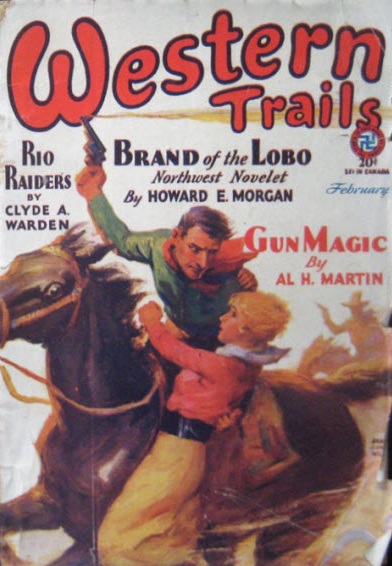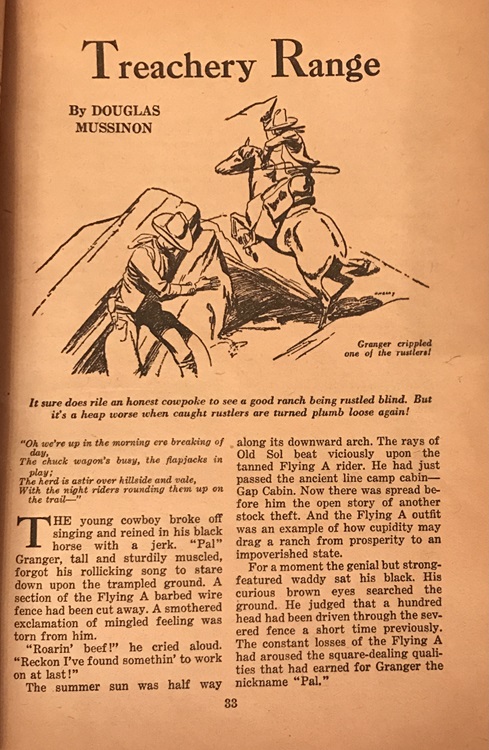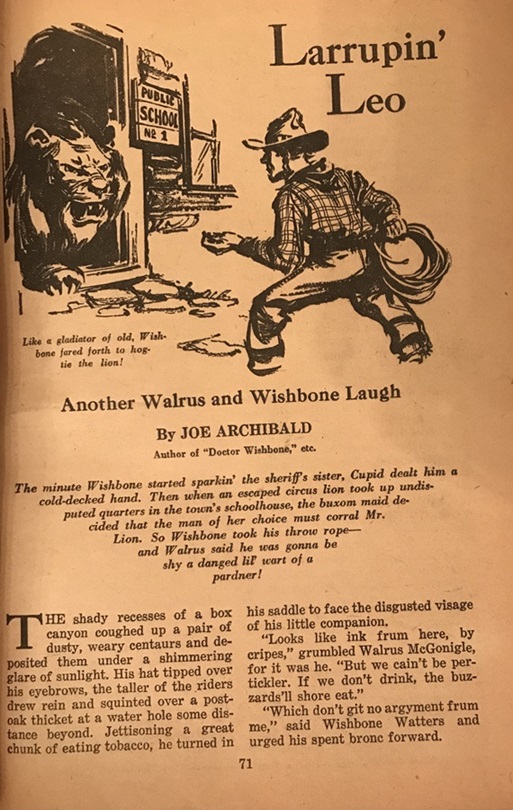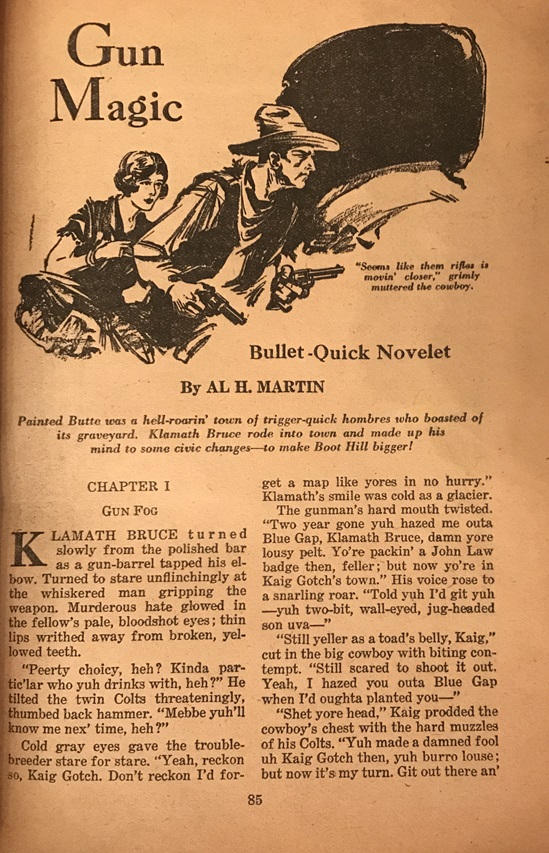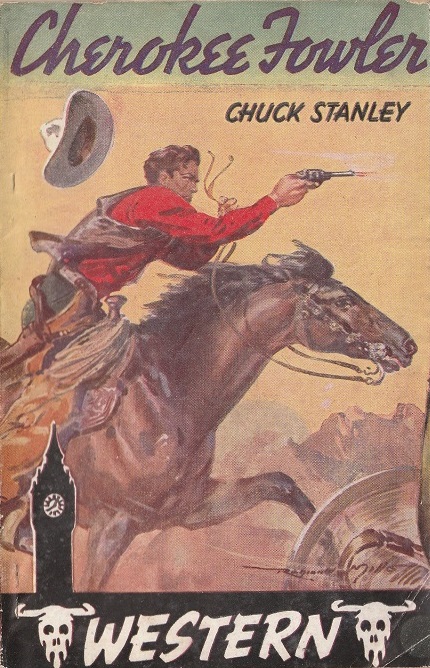Early 2023 I lucked into a large 1930s collection of the pulp Western Trails magazine. I featured many of the covers and spines from the haul in a blog early last year.
Sadly, many of the issues have vast condition flaws. Missing covers, both front and/or rear. (Those lacking front covers were not featured in that blog entry). Missing spines. Chunks of covers lacking. Front covers present but glued down to the internal page or onto an inserted sheet of paper and itself glued to the next interior page. Some covers are trimmed. The collection was largely a blind, take-a-chance purchase.
The earliest one is from February 1931 (Volume 7 Number 4). The covers are entirely lacking. Had the cover been present, it would have been illustrated by Arnold Lorne Hicks. Because the cover is missing, I’m featuring the one from the FictionMags site. All five fiction stories inside are illustrated by Don Hewitt, which I’ve presented below from my copy.
RIO RAIDERS by Clyde A. Warden
Lessiter, fast on the draw and a bear of a man, has departed the north country and hooked up with Judd Castle’s gang of former northern outlaws. He’s assigned to track Bert Little and kill him. Lessiter locates his prey; Bert is on his back, gazing up at the cerulean heavens. Bert Little says little but when he does, it’s concise and humorous. Lessiter tires of the banter and draws his gun only to have Bert, still on the ground, impossibly draw and shoot it from his grasp. His lead-dealer destroyed, Bert offers Lessiter the opportunity to fight in any manner he chooses. They go for bare-handed combat, after Bert tosses his gun-belt and knife aside. Lessiter laughs and draws a concealed blade. To his chagrin, Bert informs him that Buck, his dog, is awaiting instructions to tear him apart unless he discards the weapon. Lessiter does. Lessiter attempts to maul Little, but the slighter man is made of steel and utilizing moves straight out of a Theseus adventure, grips his man and using his muscle and speed against him, hurls the man to the ground. Eventually he ceases to play with him and lands an uppercut to the man’s chin that sends him sailing off the cliff to his death. Bert rides his horse (King) into town, reports the misadventure to Sheriff Lew Owens of Glenoa (a fictional town in the Rio region). Bert goes to his room to sleep but would-be assassin Perrado, a half-breed Mexican, enters via the window. Bert wrests the blade and interrogates the man before turning him over to the sheriff. He learns that Judd Castle intends to make Tanner’s girl his wife. Why? He doesn’t know. (Nor, for that matter, does the reader ever truly know, save that Tanner pissed off Castle once). Saddling King, he and Buck trod off into the wilderness. Pulling up some miles from Tanner’s home, Bert settles down to sleep but hears a horse approach in the darkness. Slipping free of his bedroll, Bert waits, then yanks the rider from the horse. It’s a girl! Apologizing, he learns this is Tanner’s daughter, Bell. Having heard stories of Bert Little’s deeds, she had ridden out at night to find him, because Judd Castle and two other men had captured her ma and pa. They scarcely finish talking when a loud voice orders Bert to unlimber his gun-belt. Bert does and learns he’s been taken by surprise by none other than a dead man, Lessiter! Turns out the giant did fall over the cliff but grasped at foliage and climbed safely to the top. Bert psychologically manipulates the moron to drop his gun and fight him, knife against knife. Lessiter is swiftly beaten, shirt sliced open, and his knife sent sailing free of his grasp! Lessiter receives a knock-out blow. Bert leaves the man unconscious upon the ground. He and Bell ride away, meandering in the dark towards the Tanner home. Lessiter comes to, recovers his knife and gun, and rides hell for leather to the Tanner home, beating the pair somehow in the dark. Lessiter warns Judd Castle of the pending arrival and Judd places Trundle outside to watch for Bert. A bad move, as Bert sneaks up and ties the man up. Then he opens the door, silently, and witnesses Lessiter and Castle leering above the tethered Tanners, threatening harm. Tanner taunts them to turn around. Realizing he’s too confident, they whip around and find Bert. The pair draw but are too slow. Bert puts a round into Lessiter’s chest and blows Castle away. Lessiter is still game and grazes Bert’s side, drawing blood. Bert pivots and ventilates the man’s forehead. Retrieving the tethered Trundle, Bert departs, to turn this one surviving man over to the sheriff. With Castle dead, he’s not concerned about the rest of the gang. (Gee whiz! Where are they, anyway?)
This was Bert Little’s 7th appearance in Western Trails by their prolific contributor: Clyde A. Warden, about whom I’ve already blogged, so I won’t delve any further into the author. I enjoyed this Bert Little tale enough to desire tackling the next issue on my shelf. The writing style is intriguing. A mixture of western and hero adventure with some humor. Bert’s personality feels emotionless, but he does have depth and range. I wanted to see if he was as interesting to read as western writer and blogger James Reasoner presented him to be. Trust in James! I’m not disappointed.
Treachery Range by Douglas Mussinon
Pal is riding the range when he discovers cut barb wire. Riding hard to pursue the stolen cattle, he catches two men from the ranch, the foreman and another rider. Drawing his gun, he forces the pair to push the cattle back home. Pushing them into the ranch-house, he surrenders them to the ranch boss. The ranch operations are handled by him. The original owner died, leaving behind a wife and son. The son was sent to Chicago for education and the wife mysteriously died. Now Pal must solve the mystery of who is really behind the two thieves and put things right. With the help of a few other cowboys, they capture all involved and Pal reveals that he in truth is the son, operating undercover.
This is the first time I’ve read anything by Douglas Mussinon. He authored pulp stories for about five years, from 1926 to 1931. In truth, he had only one tale in 1926, none in 1927, and really got going in 1928. Most of his works appear in Ace-High Magazine, but his last four efforts were spread out among other titles (of which this tale was the first of those four). What became of Mussinon? Born as Douglas Fredric Mussinon in 1902 (he has an entry at the FindAGrave site), he took an interest in radio at a young age, going so far as to write essays for prize competitions in various radio, drama, and play magazines. He won some prizes. Mussinon authored various script plays; they all seem to be religious. Later I found him working on a radio station in Cincinatti and then was to transfer to Oklahoma a couple years before he ultimately died, in 1947, at the age of 44. He also had a WW2 draft card entry. Why he died so young is unknown to me.
Brand of the Lobo by Howard E. Morgan
Kurt Pearson resigns from the Royal Canadian Mounted Police to pursue the mythical man who runs with a pack of wolves. This wolf man is responsible for the murder of at least four known persons, each stabbed to death and stripped to the bone by ravenous wolves. The R.C.M.P. believe the man may exist but not the myth. Kurt is also goaded on by the discovery of golden strands of hair and a tiny boot print, a female. Hiking into the far north regions of the arctic, Kurt finally catches does battle with the behemoth himself, and wins, only to be clubbed over the head by a blonde girl. Regaining consciousness, he finds a scrawled note on paper, asking him not to follow and apologizing for stealing from his pack some tea. Doubling his fortitude, Kurt quickens his pace after their trail. He eventually meets the girl, learns her name is Celie Morel, who wishes he would leave, then changes her mind. In Kurt she sees a means to escape. Following discreetly, Kurt enters via a strange pass into a secret area the girl called Mystery Valley. He’s assaulted by a tribe throwing javelins. Slipping off the precipice, he slides to the bottom into a deep snowy drift and his pulled free by his feet. The girl comes to his rescue and pushes him into her home, whereupon Celie reveals her parents were Southerners that disagreed with the Civil War and vamoosed. They traveled the world on boats and ended up in the arctic. Shipwrecked, husband and wife survived, along with a Russian, name of Shag Sarnoff. They are rescued by Eskimos who revere them, having never seen White People. Sarnoff is big but “dumb” in many ways, bestial at best. She and her brother, Paul, were born, but their father died while they were young. The mother eventually also passed away. Celie’s brother left the valley to obtain help from the outside world, but has not returned. Kurt is certain that weather may have delayed him, if not death. The Eskimo people are essentially a lost race themselves, holed-up in this secretive valley. Kurt determines the need to escape with Celie but Sarnoff convinces the Eskimos to set fire to the building. Firing off several shots out front, Kurt rapidly runs out the back way with Celie. They had for another pass out of the valley, known to only herself, Sarnoff, Paul, and a handful others. Ascending, they find the pass is blocked! Detaching his snowshoes, Kurt begins digging the pass out while Celie handles his rifle and shoots anyone trying to impale them. Kurt eventually succeeds, jumps into the small hole he’s made, followed by Celie. Strong hands grab and pull her inside to the middle of the pass. She’s mortified to find not Kurt but Sarnoff evilly grasping her. He was prepared for her to escape and meet her in the pass, and Kurt is slightly concussed, on the ground. She swings the rifle at Sarnoff, connects once, but not a second time. Kurt leaps to the rescue and the pair duke it out until he can push the razor edge of the javelin through Sarnoff’s body and several inches out the other side. The pair find themselves hemmed in. Eskimos have them trapped three-ways: from the back, from the other side of the pass, and, from above the pass they are dropping boulders! Firing and reloading as quickly as possible, Kurt and Celie eventually realize they can’t possibly outlast the overwhelming numbers. Miraculously, more gunfire joins in and Paul arrives with reinforcements to save the day. Introductions are made and Kurt and Celie, in love, declare their intent to marry.
As a fan of frozen north wilderness tales, I was thrilled to dive into this one. To find it slightly included some form of a lost race element was a bonus feature. Unfortunately, like the aforementioned Mussinon, Morgan would have a very short life. However, despite dying around January 1933 (born circa 1892) from 1923 until his death, he cranked out about 300 stories! Some were posthumously published. Thankfully, I have more issues of Western Trails with additional works by Morgan.
Larrupin’ Leo by Joe Archibald
Walrus and Wishbone are essentially the western comedy equivalent of Laurel and Hardy, and both speak relentlessly in the style of Hollywood western acting legend, Gabby Hayes. Granted, their speech predates Gabby Hayes, and I’m not precisely certain when it was developed. They are a pair of self-confessed horse thieves. In the desert they happen upon a lion that has a splinter. They extract the splinter and the lion races away after they attempt to rope it. Later, discovering the desert town of Ghost Gulch, Wishbone gets into a bar fight with a deputy sheriff. Wishbone is insanely quick on the draw and unerringly accurate. The deputy departs and later a swaying female attracts his attention. Walrus tries to snap Wishbone out of it, but apparently the slighter, smaller framed man goes loco over fine-looking females. Walrus later learns the woman is a trap, bait set by another town’s man, as revenge. Turns out that gent is previously familiar with Wishbone for having done him wrong in the past. The lion re-enters the scene and the dame states whichever male suitor captures the lion, she’ll marry. Walrus tricks his mate by feeding the lion cow-meat laced with spices and tosses one of Wishbone’s used shirts in for good measure so the lion will associate the torturous spicy food with the smell of the shirt. Next day, Wishbone brazenly walks into the building the capture what he expects to be a friendly lion, having been the one to extract the splinter. Instead, it pretty much comically mauls him and tosses him out the building.
Gun Magic by Al. H. Martin
Sadly, the lower half of a page was missing to this tale, but not enough to dissuade me from tackling it. Undercover range-detective Klamath is brought in by rancher Sagehen to solve mysterious rustling activity and deal with the devilish Dergan, described as a partial Asiatic slant-eyed gunslinger a la sleight of hand magic. Turns out Dergan was a magician in San Francisco operating under a different name. His skill unmatched, he turned his fast hands to guns and knives. A syndicate picked him up and sent him to run out ranchers with the aid of the ever-corruptible sheriff. Toss in a feisty, tough-willed woman and we have all the ripe elements for a showdown and romantic conclusion. Intriguingly, Klamath comes across like a series character that Martin missed an opportunity to develop. Absolutely enjoyed my first Al. H. Martin tale and looking forward to more. He was not terribly prolific in the pulpwoods, but managed to create one science fiction tale, The Jovian Horde, in Wonder Stories Quarterly, Summer 1932.
Page 44 asks “Do You Want a Pen Pard?” Two claim to be lovely single girls. Two are guys. One is Norman Ray of Reading, PA, and claims to be the mirror image of Bert Little. Unclear if he means in traits or looks. The other is an English soldier stationed in Egypt! His name and rank: Gunner Benwick, J. F. (Jim), 6th Light Battery, R. A., Helmieh Camp, Nr Cairo, Egypt. Phew! What a mouthful, and he looks for pards in ranch life, dudes or gals. I wonder if anyone out there can track down this fella?
Page 119 features Loco Cartoon No. 9 illustrated by Joe Archibald. Interestingly, the First Prize winner to solve the cartoon won an original cover painting previously used for this magazine. Makes me wonder which cover paintings made their way into the general populace! From this issue, the winner to No. 6 was Pink Simms of 2630 S. Montana St., Butte, Montana. I believe his real name was Harry T. Simms, buried at Mountain View cemetery on 14 December 1943, age 55.
Page 120 begins a letter column by the fictional Powder River Bill. Writers featured in the column include the following: Joseph Torra, Kitty Kuharski, Paul J. McCann, William H. Kretzman, George F. Burmeister, Genevieve Thomlette, Stanley Povlak, and one from pulpster S. Omar Barker providing some historical pieces about cattle fencing.
